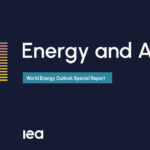- Global electricity use by data centres is projected to more than double to 945 TWh by 2030, driven largely by AI, surpassing Japan’s current consumption.
- In the U.S., AI-powered data centres could consume more electricity by 2030 than the entire industrial production of aluminium, steel, cement, and chemicals combined.
- IEA warns that unless grid bottlenecks are addressed, 20% of planned data centre projects risk delays, potentially impacting broader electrification goals.
AI’s Power Surge Redefines Energy Demand
Artificial intelligence is reshaping the energy landscape, with a dramatic rise in electricity consumption forecast for data centres as AI adoption scales. A new International Energy Agency (IEA) report warns that electricity use by data centres worldwide is expected to more than double by 2030, reaching around 945 terawatt-hours (TWh)—more than Japan’s entire electricity consumption today.
“AI is one of the biggest stories in the energy world today – but until now, policy makers and markets lacked the tools to fully understand the wide-ranging impacts,” said IEA Executive Director Fatih Birol.
The rise of AI-related computation has transformed data centres into major power consumers. In 2024, they accounted for roughly 1.5% of global electricity usage, with the U.S. alone making up 45% of that total. With AI at the core of the data surge, electricity demand from AI-focused data centres is set to quadruple by 2030.
U.S. Data Centres: The New Energy Giants
The United States is poised to be the epicentre of this electricity surge. The IEA projects that data centres will drive nearly half of the country’s electricity demand growth by 2030, surpassing the total power used for all energy-intensive industries combined.
“Global electricity demand from data centres is set to more than double over the next five years, consuming as much electricity by 2030 as the whole of Japan does today. The effects will be particularly strong in some countries. For example, in the United States, data centres are on course to account for almost half of the growth in electricity demand; in Japan, more than half; and in Malaysia, as much as one-fifth,” Birol added.
The report cautions that over 50% of U.S. data centres under development are located in just five regional clusters, raising concerns of grid strain and potential delays if infrastructure is not rapidly expanded.
Renewables and Natural Gas to Meet Soaring Demand
Meeting the rising electricity needs of data centres will require a broad mix of energy sources. The IEA notes that renewables and natural gas will play leading roles, with renewables contributing over 450 TWh and natural gas expanding by 175 TWh by 2035.
New nuclear technologies and geothermal energy are also expected to emerge, with small modular reactors (SMRs) entering the mix around 2030, particularly in the U.S., China, and Japan.
RELATED ARTICLE: World Shift to Clean Energy is Unstoppable, IEA report says
Energy Innovation and Efficiency Gains Through AI
While AI drives demand, it also offers transformative tools for the energy sector. From optimising grid operations to accelerating discovery in clean energy technologies, the opportunities are vast.
AI could unlock 175 gigawatts (GW) of grid transmission capacity without laying new lines, the report notes. Additionally, AI-enabled process optimisation in industry could save more energy than Mexico consumes in a year.
“With the rise of AI, the energy sector is at the forefront of one of the most important technological revolutions of our time. AI is a tool, potentially an incredibly powerful one, but it is up to us – our societies, governments and companies – how we use it,” said Birol.
Addressing Security and Supply Chain Risks
The report flags rising concerns around cybersecurity and critical mineral supply chains—both vital for AI infrastructure. Gallium, used in advanced chips, is 99% refined in China. By 2030, data centres could require over 10% of today’s gallium supply.
Cyber threats are also growing: AI-driven cyberattacks on energy utilities have tripled in four years, though AI is also becoming crucial in defense strategies.
Call to Action for Policymakers and Industry Leaders
The IEA stresses the need for accelerated investment in grids and generation, smarter data centre deployment, and strengthened cooperation between the energy and tech sectors. The report also introduces the IEA AI Agent, a digital tool to help stakeholders engage with the findings interactively.
“The IEA will continue to provide the data, analysis and forums for dialogue to help policy makers and other stakeholders navigate the path ahead as the energy sector shapes the future of AI – and AI shapes the future of energy,” Birol concluded.
The IEA’s “Energy and AI” special report is the agency’s most comprehensive assessment to date of how artificial intelligence is reshaping energy demand and opportunity. As AI scales, the energy sector must evolve in tandem—resilient, efficient, and ready for a digital future.
To Access the Full Report, Click Here.
The post AI’s Energy Appetite Set to Double Data Centres Electricity Demand by 2030, Says IEA appeared first on ESG News.
